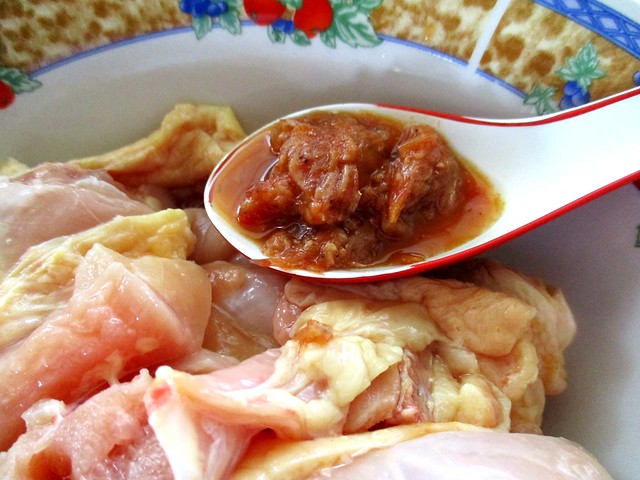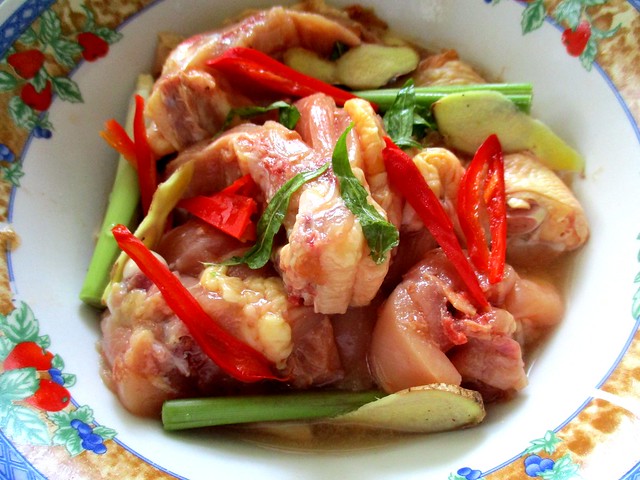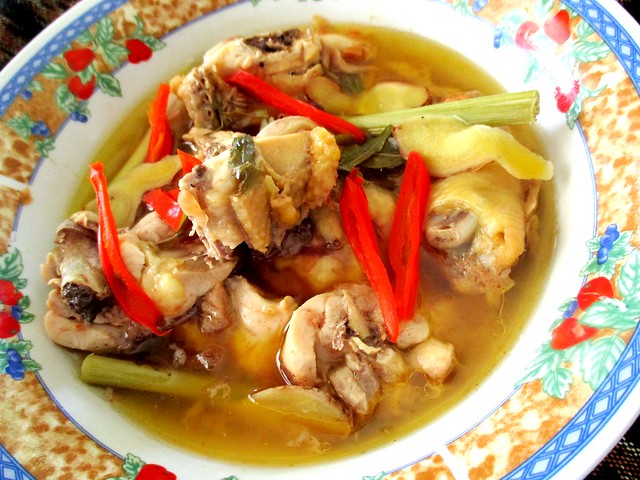This is our daun kesum…

…which is also known by a lot of names in English including Vietnamese mint, Vietnamese cilantro and so on. I think it is also called daun laksa locally and is an essential ingredient in the preparation of Penang assam laksa, together with the bunga kantan (torch ginger flower). I’ve heard it said that without these two very crucial ingredients, your bowl of Penang assam laksa is nowhere near the real thing and should not be called as such.
Of course, my plant, like everything else in my garden, is barely surviving and the leaves are kind of small but there is enough for us to use when we feel like it – after all, we do not use it all that often and we do not use all that much each time.
The ethnic population here in Sarawak use it a lot in their cooking. For instance, they would have these leaves in the celebrated ayam pansoh (chicken cooked in bamboo) along with all the other ingredients including tepus – a kind of wild ginger, serai (lemon grass), tapioca leaves and all the rest. Just as in the case of the Penang assam laksa, it is not ayam pansoh if you do not have daun kesum in it…and the tepus is an added bonus – I do enjoy eating that very much too.
Well, I think I have cooked this steamed chicken dish with tuak (the ethnic traditional rice wine) before and blogged about it but I did not have any daun kesum then so I did not add any. It’s so very easy to cook, really – I think the hardest part would be chopping the chicken into bite-sized chunks.
First, I marinated the meat with a spoonful of cincaluk (fermented shrimps)…

Do not add too much as that can be very salty (especially the ones from Melaka) but without it, one would not get the special sweetness and taste that would bring the dish to a whole new level.
Add a spoonful or two of tuak, the daun kesum, serai and a few slices of ginger…

…and I also added a bit of sliced chili.
Steam for around 30-45 minutes and your dish is ready…

…to be served.
Yes, it was very very nice – no oil, no salt and no msg added…

…and I sure would want to cook it this way again but I have used up all my tuak now – I hope I would be able to get some fresh supply or perhaps I would have to try something else, the traditional Chinese white wine that we usually use in our kacang ma chicken perhaps…and I am praying hard that my daun kesum plant will not die out on me. Sighhhh!!!!!

I interviewed a cafe owner who serves kelantanese food recently who has a garden where she plants daun Kesom. She says she spends an hour everyday plucking them and nurturing them to ensure there’s enough stock for her kitchen to use! 😉
An hour!!! She must have had a lot. I wonder what she does – mine sure needs a lot more tender loving care.
Foe sure, I would like to try this dish. Such easy peasy & hassle free to dish out and anything with cincaluk, I am in. By the way, what is daun kesum called in Hockkien? Am zero in names of plants.
I haven’t the slightest idea. We used to buy at the ethnic jungle produce market before we planted our own so we just said daun kesum. I wonder what bunga kantan is in Hokkien as well. Don’t think they have names for these – not used in their cooking.
Your steamed chicken looked good and appetizing!!
Those daun kesum should not be hard to plant as it is wild. Grow freely on ground. Haha.
It is nice…and so easy to cook.
Sighhh!!!! People say that it is so easy to plant mani cai, just push the cuttings into the ground. I tried…and failed. 😥
Steamed dish – very healthy. We are also doing more steamed dishes in our old age.
Yes, steamed, boiled or roast…no added oil, anytime better than stir frying or grilling or worse, deep frying.
Yumm! Looks healthy meal.
I’ve tried planting edible plants. Seems that they are not ready to live in my hands. Bahaha.
Looks like we’re setengah kati, lapan tahil…exactly the same. Even the simplest to plant plant that I planted…died. 😦
I love Daun Kesum, cooking it with chicken and cincalok is a novel idea, but I know it is very delicious.
I tried once with the tual and without the cincaluk and it was not as nice so in the end, I added that in. Sometimes, when we do without a certain ingredient, it simply is not the same.
If I were to cook this, I have to get tuak, cincaluk and the kesum leaves… looks like a very nice dish no doubt.. I think I will steam the chicken with lemongrass, some chillies and wine… 🙂
Would taste good too but the cincaluk will add to the sweetness and the taste – the wine and daun kesum are optional but of course, it depends on how nice you want your dish to be. Sometimes, we can’t have everything – just make do with what we’ve got.
I had no idea that daun kesum is widely used in Sarawak cooking. I also have a daun kesum plant in my garden and it is also not doing too well, so puny. Your steamed chicken dish looks good. I want to try it but I hope that Chinese wine would be OK because I can’t get tuak here.
You can try whisky! That would be nice too…or vodka! Not too sure about Chinese wine – maybe the traditional white one would be nice but I think the ones over there are very sweet. That may affect the taste, don’t you think?
Lucky i taken my dinner already, if not, i will drool over it… hehe…
Oh? So it did not get you drooling? Sighhhhhh!!!! 😦
I would think anything will go well cooked with cincaluk.. as long as we don’t put too much of it, or it will get too salty! 😛
daun kesum.. hmm, i think i have tasted it, but like everything green, I can’t differentiate one from the other!
So you don’t know it they have it or not in your bowl of Penang assam laksa. Hmmmm….a food blogger some more? Hehehehehehe!!!!
Yes, the cincaluk from your side is extra salty, not much fragrance. Well, when one cannot put too much, even in a simple dip, how to get the very nice taste and fragrance? Our Bintulu ones are a lot nicer…but then again, we know where to get the good ones. There are the not-so-nice ones as well, red from all the colouring used – I would not bother about those.
I have grown daun kesum here very successfully in the summer. In fact had to thin it out. Maybe check the soil in your garden? Tried to bring it indoors in a pot, epic fail.
Thin out? Mine’s so very “thin” but yes, I think it has got something to do with the soil. Same ol’ soil since I moved in almost 30 years ago and many other plants had been growing on that same soil since. 😦 But my basil plant growing in the pot it came in…is sharing the same fate, “skinny”, struggling to stay alive but yes, it is still alive. 😀
I thought you wrote daun ketum at first. Haha. I had to reread it three times coz I automatically thought daun ketum. There’s still a fair bit going around in East Coast last time I went (few years ago). They’re selling it openly, RM 1 per bag. It’s actually illegal coz it has drug-like effects (feels like opiates) but a member of parliament actually consumes it and champions it, was surprised to hear someone in that position say that. Normally, it would be political suicide, but it’s really accepted in the East Coast.
Even daun sireh, I heard, will get one high. Add the kapur and chew with buah pinang and a first-timer’s head would go spinning. Maybe the effect is not so much if one eats it regularly, I wouldn’t know.
Ketum is really powerful (relatively) though. It’s a mixed opiate agonist and antagonist so it’s kinda like a natural version of Tramadol or buprenorphine. It doesn’t do much for me but for an opiate naive person, a RM 1 packet will definitely get them high. It feels like 160 mg of codeine which isn’t much for a long time opiate user but a first time user will be as high as a kite. 🙂
Yes, like the first puff of the cigarette after a long time cold turkey and the world would go spinning.
I love the flavour of fermented shrimps and we have something similar in the Philippines called bagoong, such a flavourful ingredient but yes it has to be used with care
Yes, I do think it is the one and the same thing. Never tried the ones from the Philippines though – the ones from Melaka over in the peninsula are extra salty and not as fragrant. To me, not so nice. I prefer the ones we have here, the good ones, that is – there are not so good ones around as well.